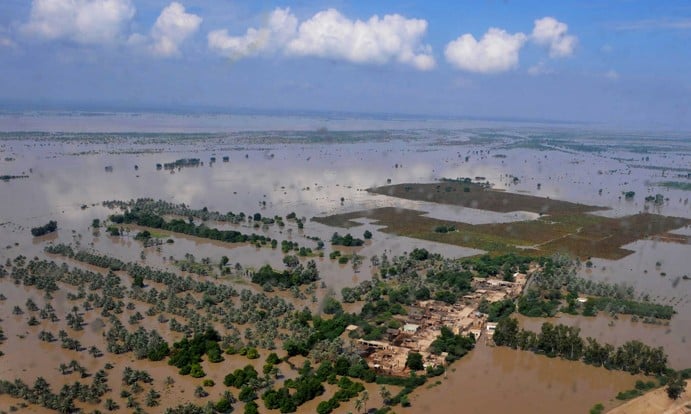
Pakistan is one of the many developing countries whose contribution in the global emissions is meagre, yet its vulnerability to climate change impacts is enormous

As the clock ticks towards the upcoming global agreement to address climate change beyond 2020 at the 21st Conference of Parties (COP21), countries work towards formulating a nationally determined comprehensive set of actions and strategies against climate change.
Since the beginning of this year, Pakistan is working hard to finalise its set of Intended Nationally Determined Contributions (INDCs) through a rigorous process involving national level workshops, stocktaking and inter-ministerial sessions, with the goal to submit the contributions by September.
Pakistan has adopted a tri-sectoral approach, targeting these sectors with proposed policies, programmes and projects. These sectors include energy and transport, agriculture and forestry, and industry and waste.
While the main objective of INDCs is to come up with ambitious but actionable mitigation plans, developing countries are required to include practical adaptation plans that will help build resilience to the burgeoning adversities brought forward by climate change. Regrettably, the approach adopted by Pakistan lacks an encompassing focus on adaptation and chooses to concentrate its efforts on mitigation.
Both adaptation and mitigation are essential responses to curtail the negative impacts of the continuously rising threats of climate change. Where mitigation is concerned with limiting and reducing the quantity of greenhouse gas (GHG) emission, adaptation intends to reduce the vulnerability of human and natural systems to climate threats.
Pakistan is one of the many developing countries whose contribution in the global emissions is meager, yet its vulnerability to climate change impacts is enormous. A recent report launched by the Ministry of Climate Change in collaboration with the United Nations Development Programme states that Pakistan is responsible for about 0.8 per cent of the total global greenhouse gas emissions, whereas it ranks 3rd amongst the 10 most vulnerable countries to climate change.
The recently launched Climate Public Expenditure and Institutional Review (CPEIR) report states that Pakistan spends about 6 per cent of the total federal budget (development plus current) on climate change related expenditures (according to 2013-14 figures). Of this, more than half (54 per cent) of the expenditures are bagged by mitigation actions, whereas adaptation investments receives only about 26 per cent of the total climate expenditure.
"GHG emission of Pakistan is not much if we consider the per capita percentage of emission. However, the total emission percentage is not negligible and will rise to be a great threat in the near future if we don’t invest on mitigation response," said Sajjad Haider Yaldram, Deputy Secretary at the Ministry of Climate Change, explaining the reason for Pakistan’s greater focus on mitigation response. No doubt, a proactive approach as taken up by the ministry is commendable, nevertheless, focusing on future threats while not giving due attention to the current needs may come at a heavy cost.
Keeping the disproportionate impact of climate change and its related extreme events in mind, developing countries are given a special leverage to include adaptation plans in their INDCs. However, the INDCs of developing countries depend on the funding they are to receive. Commenting on the issue, Mr. Yaldram said, "the amount of finance available for mitigation measures is five times more than that available for adaptation".
Ironically, it is true. The bulk of finance available to manage the risks of climate change is reserved for mitigation purposes. According to the Overseas Development Institute (ODI)-run website, climatefundsupdate.org, the total amount of adaptation funds that has been pledged worldwide aggregates to about $3,335 million against a total of $7,227 million for mitigation. This clearly demonstrates the wide gap between the availability of funds available for the two responses against climate change.
Although adaptation funds are increasing with time, but the proportion of this increase is not adequate for meeting the adaptation demands of the developing countries. Out of the pledged amount for adaptation, Pakistan has received a total of $7.3 million for its adaptation needs, which falls too short of its requirements considering the heavy price that it pays due to climate change and related events every year. On the other hand, it has received $13.5 million for its mitigation programmes and projects. Against these amounts, the country faces losses amounting to $6 billion due to climate change, according to the CPEIR report.
With the impacts of climate change multiplying at a faster rate than ever, the question is obviously not about choosing mitigation over adaptation or vice versa. Both types of responses are significant and are essential for an effective strategy to counter the threat of climate change. However, considering the disproportionate effects of this threat, especially on the developing countries that lie in climate hotspots, there is a dire need to prioritise the nature of state response. Adopting a futuristic approach by focusing on mitigation by developing countries is appreciated, but it is only justified when the countries have devised ways to deal with the on-going changes by adapting to them. This calls for availability of more funds to be directed at adaptation in order to prepare ourselves for climate risks and related disasters.